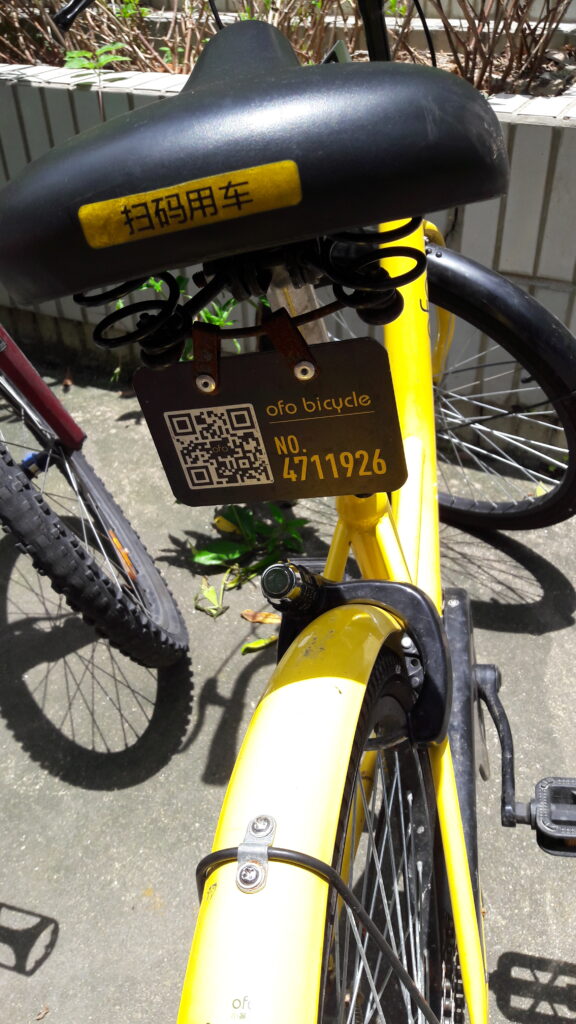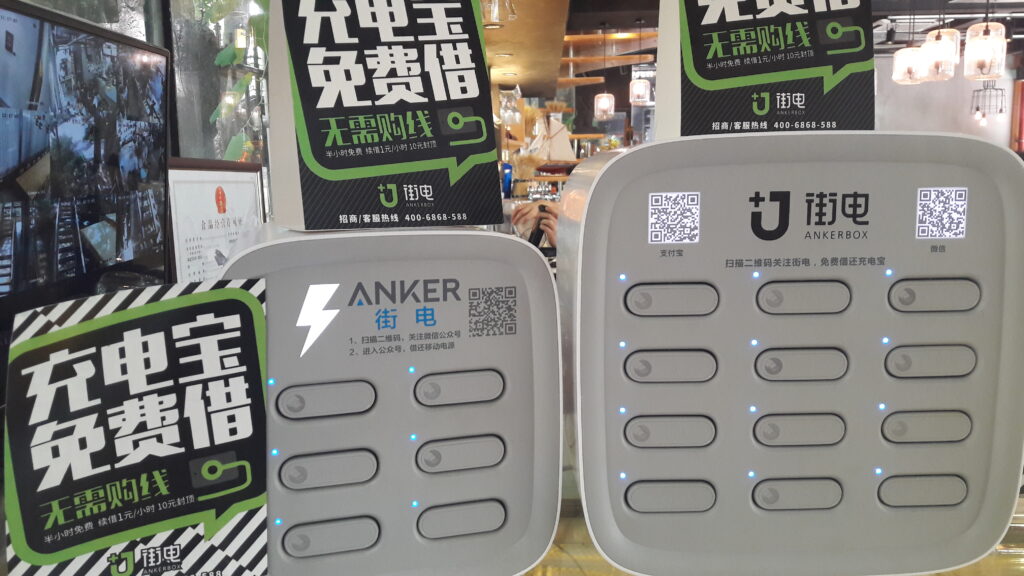China (or at least Shenzhen) is now barcode land. This is perhaps one of the most surprising things and different aspects of life in Shenzhen. Locals here boast about the fact that you can leave your house without anything but your phone – your phone can do literally everything for you. I’ve had a QR-code barcode reading app installed on my phone for some time, but I’ve never really used it. Frankly, I never really saw the point of the technology – scanning a QR code on an ad in a bus shelter could save you the time of typing in a 10-letter web address, but so what? But China has really put QR codes to their full use. So, what can you do with them?

- You can make friends! If you have WeChat, which of course everyone in China does, then you can connect with people in various ways. One way is to type in their Wechat ID. But this is so 2010. Your Wechat account also comes with your unique QR-code. So if you want to make friends with someone, you can just ask, “Can I scan you?” They display their Wechat QR-code on their phone and you can use your phone to scan it and WeChat add them as friend for you.
- Pay for (almost) everything! There are two big players in China battling it out for dominance in this space: WeChat (owned by Tencent) and AliPay (owned by AliBaba). AliPay is first and has more of the market but WeChat is catching up. And at least in Shenzhen, most places seem to accept both. The range of places that accept such payments is remarkable – everything from public / government organizations (like paying your gas bill) to street vendors with a push-mobile food cart. I set up WeChat Wallet, which works through my WeChat account. There are two ways that this works. The most common is that the vendor displays a barcode somewhere near the payment counter (some cafes, bars and restaurants have a little laminated version that they will take around from table to table). You scan the barcode with your phone in WeChat and it takes you to a payment page unique to that vendor. You then type in amount you need to pay and enter a payment code (basically a pin number). The payment is then made from your bank account. Usually, you flash the “Payment successful!” screen at the waiter, barista, or bartender to show them you have paid. Some vendors, usually larger ones, will have a dedicated QR-scanner at the register. When you are ready to pay, you tell WeChat to generate a payment QR-code on your phone screen – this is good for one use and is refreshed every minute. The vendor scans your phone with their machine and payment is immediately confirmed through a WeChat message.
- Rent a bicycle! Recently many cities around the world have started bike-share programs. In many cases the processes for registering and paying are quite cumbersome. In China everything works via a QR-code. Scanning the barcode on the back of the bike will unlock it. A deposit is automatically held through your WeChat or AliPay account. And when you return the bike, the rental fee is also automatically deducted.
- Watch TV/movies online! Somewhat to my surprise, it’s relatively difficult to watch movies or TV for free on the Chinese Internet. The big video sharing websites – Youhu and Soku – actually make you pay for content(!). To make a payment, a QR-code pops up your laptop screen – scanning the code with your phone sends you to a page where you can authorize a payment of a few dollars to watch. As soon as the payment is made, the webpage refreshes itself and the show begins to play.
- Charge your phone! Many vending machines also accept online payments via QR-code. Also restaurants and other public places have loanable chargers for mobile phones that are operated by scanning a barcode.

There are also a number of other kinds of payments that you can make via WeChat or AliPay on your phone, such as utility bill payments, topping up your mobile phone credit, buying airline tickets, sending money to your friends, movie tickets, taxis (DiDi), and train tickets. These don’t use barcodes, but they seem to be remarkably well integrated. Perhaps the most surprising was that I could top up my Shenzhen metro (public transport) card using my phone! Holding the RFID card to the back of my phone popped up a prompt to use various payment methods – by selecting WeChat, I could pay top up the card by selecting the appropriate amount (I did this while I was on the train). This uses a technology in your phone called NFC (Near Field Communication) which is apparently in most phones, but I don’t think I’ve ever used it in my phone.
Obviously all this is cool and makes life easier in various ways. Some people complain that it makes it too easy to spend money – paying with a barcode doesn’t seem like “real money” so there is a tendency to drain the bank account faster. I’m sure this was a worry with early credit cards too. But the integration of payments into platforms like WeChat does represent a gamification of money and spending.
What I wonder about in this barcode world is what other information is being shared via our barcodes and payments? QR codes come in various sizes, but the maximum size is 177×177 rows and columns. This size can store 4 kilobytes of data. That’s not a great deal when we take into account the fact that the code must include some standard data such as formatting data and error correction data. But it seems like enough to include information about where, when, and what I am shopping for or where, when, and who I am WeChat friending.
Where is this data going? Some data about me is certainly being given to the vendor when I make a payment. A few stores that I have made purchases from have begun to send message to my WeChat giving me updates about specials, sales, and so on. No doubt AliBaba and TenCent are collecting all this transaction data too. The automatic linking of personal/friendship/social media data to payment/consumer data seems like a big data dream come true.
What is ironic about this is that barcodes are a visual technology – they are right there for us to see, and they rely on the cameras in our phones in order to function. But they are opaque to us; they are not designed for human eyes. The data they contain is both within our sight but also invisible to us. We are being “seen,” our phones are “seeing” but we are unable to see. Barcodes create forms and regimes of legibility that are available only to machines.
As barcodes, QR codes, smart devices, and the Internet of Things become increasingly ubiquitous, we are increasingly surrounded by new languages, by new symbols and codes that we can see but cannot read or understand (or at least not without the aid of a device). In the Terminator movies, we are given views from the eyes of the machine – he (or she) can see all sorts of things (and in all sorts of ways) that humans cannot. Now we too need to “see like a machine”; to fully apprehend our environment, we need phones, tablets, and other devices to do the reading and seeing for us and with us. This is a form of augmented reality — and a form of becoming a cyborg – that is all around us, and yet which we hardly notice.
